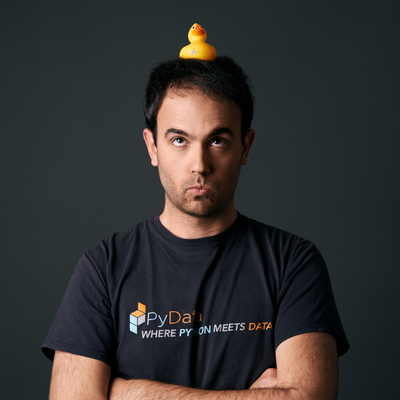Did #julialang end up kinda stalling or at least plateau-ing lower than hoped?
I know it’s got its community and dedicated users and has continued development.
But without being in that space, and speculating now at a distance, it seems it might be an interesting case study in a tech/lang that just didn’t have landing spot it could arrive at in time as the tech-world & “data science” reshuffled while julia tried to grow … ?
Can a language ever solve a “two language” problem?
@maegul @programming Maybe nobody (save for the Julia developers) ever cared about the “two language problem”. I see folks are just happy writing high performance tools in Rust with Python wrappers.
In any case, I’m happy that the Julia folks gave birth to things like DifferentialEquations.jl, truly a piece of art. Anything that helps scientists and engineers move away from MATLAB is welcome.
deleted by creator
@tschenkel @astrojuanlu @programming
I’d suppose part of the problem might be that there’s a somewhat hidden 3rd category of user that “feels” whatever added complexity there is in a two-language lang like julialang and has no real need for performant “product” code.
And that lack of adoption amongst this cohort and your first enforces lang separation.
I may be off base with whether there’s a usability trade off, but I’d bet there’s at least the perception of one.
deleted by creator
Considering, it may be worth highlighting that tools like Jax exist as well (https://github.com/google/jax). These have even become an expected integration in some toolkits (e.g., numpyro)
It may not be the most elegant approach, but there’s a lot of power in something that “mostly just works and then we can optimize narrowly once we find a problem”
It doesn’t make a solution that solves this mess bad, but I do wonder about it being a narrow niche
deleted by creator
Mostly its advantage as far as arrays go is its ability to push things out to an accelerator (GPU) without making code changes. Also its JIT functionality is a good bit faster than using pytorch’s (at least anecdotally).
My experience with it is not at all related to ODEs (more things like MCMC) and I have no direct experience with its gradient functionality and only limited with its auto vectorization, so take my experience with a grain of salt.
@hrefna @tschenkel @astrojuanlu @programming
Yea … it seems that things like this are part of Julia’s problem …
that for many the “two language problem” is actually the “two language solution” that’s working just fine and as intended, or as you say, well enough to make an ecosystem jump seem too costly.
deleted by creator
@tschenkel @astrojuanlu @programming
I understood … I was reaching for some shorthand (500 char limits FTW!)
There’s probably a good amount of work that exists somewhere between your needs and “could be a spreadsheet”, where caring about performance isn’t an issue or hasn’t surfaced yet, either practically or culturally (where the boundaries of what research *can* be done “tomorrow” are of importance)
BTW, cheers for all the info!!
@tschenkel @astrojuanlu @maegul @programming I completly agree with your second point.
> Maybe nobody (save for the Julia developers) ever cared about the “two language problem”
Yea, it’s what prompted my post. I saw in a rust forum push back on the two language thing but from the lower level side (where they were arguing about introducing lazier memory management facilities on the basis that you should just use swift/Python etc).
And re MATLAB … absolutely! This is not a diss against Julia at all.
Anything that helps scientists and engineers move away from MATLAB is welcome.
The MATLAB language may be pretty bad but IMO that’s not what makes MATLAB good. Rather it’s:
-
Every signal processing / maths function is available and well documented. I don’t know how well Julia does on this but I know I wouldn’t want to use Python for the kinds of things I used MATLAB for (medical imaging). You don’t have to faff with pip to get a hilbert transform or whatever…
-
The plotting functionality is top notch. You can easily plot millions of points and it’s fast and responsive. Loads of plotting options. I just haven’t found anything that comes close. Every other option I’ve tried (a lot) only works for small datasets.
@FizzyOrange The problem with Python for signal processing and stuff like that is not pip (I know it’s a meme by now, but it’s really not that bad) but rather, the fact that some SciPy subpackages are barely maintained
-
IMO Julia just had way too many big issues to gain critical mass:
-
Copied 1-based indexing from MATLAB. Why? We’ve known that’s the worse option for decades.
-
For ages it had extremely slow startup times. I think because it compiles everything from C, but even cached it would take like 20s to load the plotting library. You can start MATLAB several times in that time. I believe they improved this fairly recently but they clearly got the runtime/compile time balance completely wrong for a research language.
-
There’s an article somewhere from someone who was really on board with Julia about all the issues that made them leave.
I still feel like there’s space for a MATLAB replacement… Hopefully someone will give it a better attempt at some point.
Yea I remember reading about some deeper issues with the language (Dan Luu was quite dark on it I think) and that more or less turned me off. At the time I would have had to have been amongst some dedicated users urging me on to consider adoption.
I still feel like there’s space for a MATLAB replacement…
GNU Octave?
https://en.wikipedia.org/wiki/GNU_Octave
using a language that is mostly compatible with MATLAB
The only benefit Octave has over MATLAB is that it’s free. Which is something I guess, but in practice it is MATLAB without the benefits of MATLAB.
It’s plotting functionality sucks as much as anything else, it has fairly good toolkit support but not remotely like MATLAB, and it still has the mediocre MATLAB language. Worse - with custom incompatible extensions!
-
Why is everyone in this thread constantly putting meaningless @ mentions at the top of their replies?
The thread was started as a toot by a Mastodon user. All of the replies are actually Mastodon posts. Thanks to the magic of the Fediverse, these render in Lemmy as comments.
As cool as that is, it does end up looking confusing. Maybe some quick visual indication (possibly customized by each user) to show source of comment could help.
💫 the magic of the Fediverse ✨
Yea I try to post from mastodon when it makes sense. You’re seeing the mentions as that’s how mastodon links things together. Here on lemmy, the connections are all more structural and so implicit.
This is about as good as lemmy-mastodon interaction can be: when someone posts from mastodon to a lemmy community.
Though now, with automatic hashtag-ing since v 0.19.4, the two can work together better. See https://hachyderm.io/@maegul/112720255264101773
They’re most likely actually responding from Mastodon.
Python was first released in 1991, Julia in 2012. I think it may be too soon to call the race.
Problem with that logic is that python was essentially “reborn” at some point 2010-2012.
That’s when scipy, pandas and notebooks all came together, and with early pandas putting python on the map more than some (cough - Guido - cough) are willing to admit.
Of course the maturity of the ecosystem by then is part of it … but also pushing through the python 3 situation wasn’t trivial and likely speaks to the momentum the science stack brought to the ecosystem.
In a real way it feels like there’s a “hump” with language adoption. Some languages clear it, some don’t, and I don’t think we have a good feel as an industry for what makes a language “successful” in this regard.
Some things obviously help, other things obviously hurt, but mostly what succeeds or doesn’t seems to be a matter of luck intersecting with need.
So at my previous employer I developed using Julia a custom ML model which ran, but the performance just wasn’t good enough for what I needed despite trying to aggressively optimize. I ended up rewriting in Rust (and calling through R) which ended up being like 10x faster. At my current job I program a mixture of Rust and Python.
If Julia were more peformant then it could potentially be an alternative to Python/R users having to learn Rust - but if you’re looking for top performance, some of your codebase is already written in R/Python, and you’re already willing to learn another language, then learning something like Rust naturally seems the better choice over Julia.
The one thing I did like about Julia - it took barely anytime at all to build a working prototype.
In general, how much more performant would you say Rust is or can be than Julia? Any good resources on this?
What’s interesting about this take is that it targets the whole “two language” thing and implies that it might be a fool’s errand.
I think it really strongly depends on what you’re programming - I know in some instances Julia’s performance can be nearly identical to languages like Rust. I suspect in my case it related to Julia being a garbage collected language, as my algorithm involved creating very large dynamic structures in memory before serializing them, clearing the memory, and building another one. Since Rust has no garbage collector it knew exactly when and what to drop from memory. In my case I had roughly a 10x(!!) speed-up. Funny enough an even earlier version of that algorithm was programmed in Java, and Julia was roughly 10x faster that it, so Julia isn’t the worst of the pack.
@maegul @programming Perhaps this is all kind of like evolution: something that evolves to be sufficient doesn’t necessarily need to further evolve to some pinnacle (however that may be defined it its context). R and Python are imperfect in so many ways, but sadly it gets the job done for most folks. I think people who explore Julia are simply not content for one reason or the other with R and Python (perhaps also Matlab), but they likely have gotten a lot of work done with R & Python.
@maegul @programming I had already switched to Python to solve the “Matlab problem”. I’ve been Julia-adjacent, looked at it with an open mind but it doesn’t make sense to switch to it when I can do almost everything I need in Python. A little diss here, just when we arrived at a free, available solution for widely available sci/biz programming envrionment (Python) Julia peeled off some whose code becomes unusable for most consumers of code.
Julia was my scripting and util programming language of choice for a while. But it couldn’t keep me. I’m not too confident in the reasons anymore, it’s been quite a while ago. I think the dynamic, unsafe aspect was a part of it, but also how it felt overall, or with code structuring?
Maybe I’ve been pulled away by better alternatives. (Using C# also for smaller util projects.) Recently, I’ve been using Nushell for scripting, which is new syntax to learn, but I’ve been enjoying functionality-wise.












